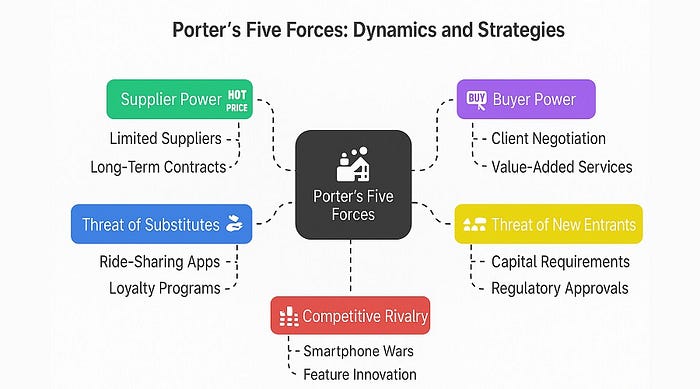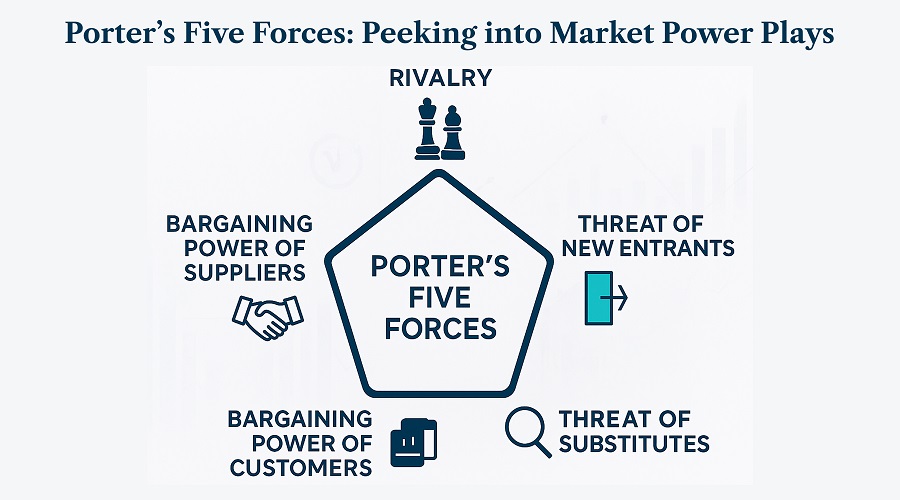Hello! Have you ever felt that you are a small fish in a big industry pond and wondered who’s really pulling the strings? Michael Porter’s Five Forces framework is your secret decoder ring to understand market power. In this informal guide, I will share personal experiences intermixed with expert insights and a fun exercise to assist you in mapping out the competitive landscape and thus making strategic decisions with confidence.
What Is Porter’s Five Forces?
Industry competition is a fairly straightforward concept with a scientific approach. Harvard professor Michael E. Porter, in fact, had introduced a model in 1979 to analyze five forces: supplier power, buyer power, threat of new entrants, threat of substitutes, and competitive rivalry. This, in effect, gives you an all-around 360° view into what drives profitability in your market.
“The essence of strategy is choosing what not to do.” — Porter
The Five Forces Unpacked
Let’s dive into each force, peppered with real-world examples and a dash of my own experience.
- Supplier Power: Imagine you run a small cafe and one day your only bean supplier decides to increase price by 20% overnight. That is high supplier power. I learned it at my Bangalore café pop-up: never keep your suppliers limited, or negotiate long-term contracts so prices do not soar.
- Buyer Power: Have you ever been squeezed by a client who knows you need their business? That is buyer power at work. Back in my freelance web-design days, one of my corporate clients almost walked out if I did not match the low bid that went against me. I countered by pitching a heady combination of hosting, maintenance, and SEO that no one could say no to, limiting their price squeeze.
- Threat of New Entrants: Some industries are liberal, such as mobile apps, with just a laptop and the will to launch a startup. Other industries such as commercial airlines require enormous capital, licenses, and safety approvals. Those huge barriers discourage potential newcomers and tend to preserve incumbent firms.
- Threat of Substitutes: Price power erodes with the advent of alternative solutions. Think of traditional taxis vs. ride-sharing apps. Almost all taxi firms, confounded by a reduction in their market power, launched mobile apps and loyalty programs in a bid to battle these innovations that act as substitution threats.
- Competitive Rivalry: Like I said, this is the heart of the battlefield. The smartphone wars sees brands like Apple and Samsung outdoing each other in features and pricing all the time. I remember changing phones countless times just in pursuit of “the next big thing.” That’s competition for you!

Your Secret Weapon: The Force Map
Want to make this framework yours? Try my Force Map exercise:
- Rate each force on a scale of 1 (weak) to 5 (strong) for your industry.
- Plot the scores on a simple radar chart or even a hand-drawn star.
- Connect the dots-a spiky shape highlights areas of high pressure, while a smoother outline shows your sweet spots.
When I helped a regional gym chain, they identified a glaring “5” with regard to new entrants in their map. By offering a flexible online class system with membership perks, they increased entry barriers and smoothed out their competitive profile-massive 25% growth in six months!
Why It Matters for You
The Porter Five Forces analysis tool gives an entrepreneur or a Fortune 500 executive a way to assess forces acting on a particular industry:
- Clarity on where profits hide (and where risks lurk).
- Focus to decide which battles to fight — price wars or innovation races.
- Strategy to build defenses (like exclusive partnerships) or exploit opportunities (like underserved customer segments).
Conclusion
Far from being some mere academic theory, Porter’s Five Forces provide a practical toolbox revealing those never seen power plays around which an industry is established. Strategic clarity is crystallized and will point out your next winning move when the supplier and buyer dynamics, entry threats, substitution threats, and intense rivalry are analyzed. Grab your Force Map now, go into your market, and begin your charting of sustainable advantage.
If you are a researcher and finding it difficult to apply frameworks such as Porter’s Five Forces in your thesis, don’t worry. Our Thesis Writing Assistance service is designed to simplify complex concepts, provide clear analysis, and ensure your work meets academic standards. Get expert support today and take your research to the next level with confidence.
FAQ’s
1. Why use Five Forces over SWOT?
Porter’s Five Forces are external market pressures, while SWOT mixes both internal and external factors. Use both for a full picture.
2. How often should I revisit my analysis?
At an annual level, and whenever there are significant industry changes such as new regulations, a big competitor consolidation, or a tech disruption.
3. Can a small business benefit?
Absolutely. A corner bakery could chart supplier power (flour mills), buyer power (caterers), and rivalry (other cafes).
4. What’s a good Force Map tool?
You can sketch it by hand or use free templates in Google Sheets, Lucidchart, or Canva.
5. Are there criticisms of the model?
Some say it is static and misses collaboration. Use it with dynamic tools such as Value Chain Analysis for a deeper insight.





Comments